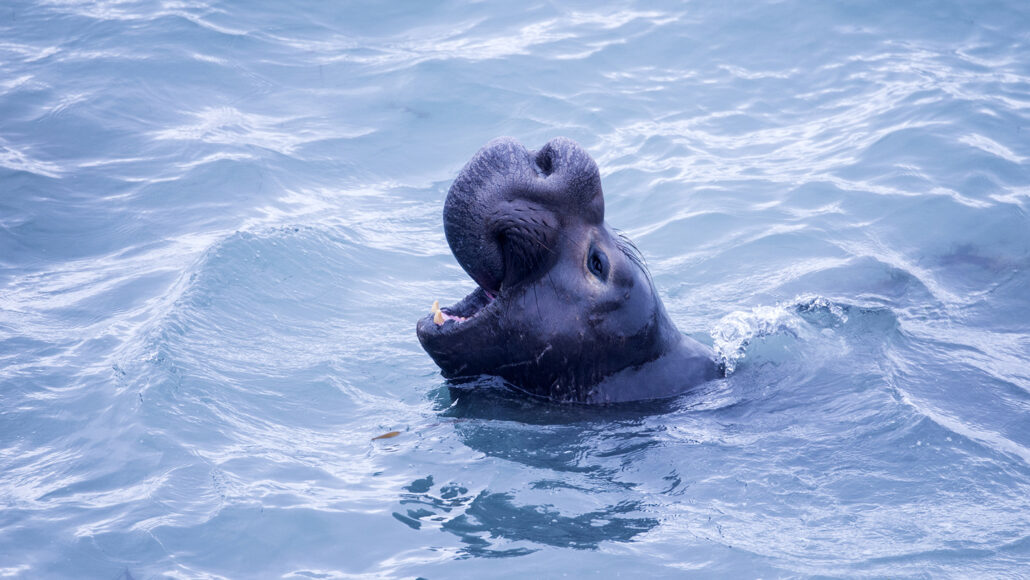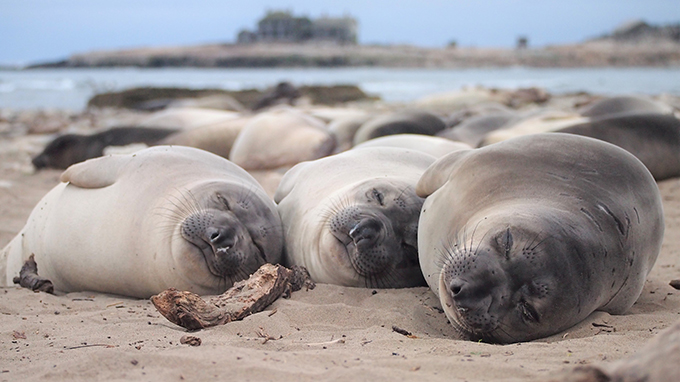Northern elephant seals snooze only two hours a day at sea
The marine mammals sleep less than 20 minutes at a time during dives

Northern elephant seals are deep sleepers. Literally. They dive hundreds of meters (yards) below the ocean surface to take naps where they’re safe from sharks or killer whales.
Mark Newman/Getty Images
Northern elephant seals are the true masters of the power nap.
These marine mammals swim at sea for months between brief breaks on shore. During those sea voyages, the seals snooze less than 20 minutes at a time. On average, they get a total of just two hours of shut-eye per day.
This extreme sleep schedule rivals African elephants for the least sleep seen among mammals.
Researchers shared the discovery in the April 21 Science.
“It’s important to map these extremes of [sleep behavior] across the animal kingdom,” says Jessica Kendall-Bar. She studies marine mammals at the University of California, San Diego. Learning how much or how little sleep different animals get could help reveal why animals, including people, sleep at all.
Knowing how seals catch their zzz’s also could guide efforts to protect places where they sleep.
Tracking seal sleep
Northern elephant seals (Mirounga angustirostris) spend most of the year in the Pacific Ocean. At sea, those animals hunt around the clock for fish, squid and other food.
The elephant seals, in turn, are hunted by sharks and killer whales. The seals are most vulnerable to such predators at the sea surface. So they come up for air only a couple minutes at a time between 10- to 30-minute dives.
“People had known that these seals dive almost all the time when they’re out in the ocean. But it wasn’t known if and how they sleep,” notes Niels Rattenborg. He wasn’t involved in the new study, but he has studied animal sleep. He works in Seewiesen, Germany, at the Max Planck Institute for Biological Intelligence.
Kendall-Bar’s team wanted to find out if northern elephant seals really do sleep while diving. To do this, the researchers outfitted two northern elephant seals with special caps. Those caps recorded the animals’ brain waves, revealing when they were asleep. Motion sensors were also strapped onto the seals.
By looking at both brain-wave readings and motion data, the researchers could see how seals moved while asleep.
Kendall-Bar’s team took their two seals from Año Nuevo State Park. That’s on the coast of California, north of Santa Cruz. The researchers then released the seals at another beach, one about 60 kilometers (37 miles) south of Año Nuevo. To swim home, the seals had to cross the deep Monterey Canyon. The waters here are similar to those in the deep Pacific, where the seals swim during their months-long trips at sea.
Matching the seals’ brain-wave readings to their diving motions on this journey showed how northern elephant seals get their sleep on long voyages.
Deep-sea snoozes
The data revealed that when a northern elephant seal wants to sleep at sea, it first dives 60 to 100 meters (200 to 360 feet) below the surface. Then, it relaxes into a glide. As the seal nods off, it keeps holding itself upright for several minutes.
But then, the seal slips into a stage of rest known as REM sleep. During this sleep stage, the animal’s body becomes paralyzed. A slumbering seal now flips upside-down and drifts in a gentle spiral toward the seafloor.
A northern elephant seal can descend hundreds of meters (yards) deep during one of these naps. That’s far below the waters where sharks and killer whales normally prowl. When a seal wakes after a five- to 10-minute nap, it swims back to the surface. The whole routine takes about 20 minutes.
Now that Kendall-Bar’s team knew how seals moved during sleep, they could pick out naps in motion data from other seals who hadn’t been outfitted with the special caps.
The researchers looked for naptime dive motions in tracking data on 334 other northern elephant seals. Those seals had been outfitted with tracking tags from 2004 to 2019. The seals’ movements revealed that while at sea these creatures conk out, on average, only around two hours per day.
But northern elephant seals aren’t short on sleep all the time. They snooze nearly 11 hours per day when they come on land to mate and molt. On the beach, they can catch up on sleep without worrying about getting eaten.
“What the seals are doing [at the beach] might be something like what we do when we sleep in on the weekend,” Rattenborg says.

Extreme animal sleep
Northern elephant seals aren’t the only animals that sleep very little, at times, and then a whole lot. Rattenborg’s group has found a similar sleep pattern in great frigate birds. They fly over the ocean. “They can sleep while they’re flying,” Rattenborg says. So on those trips, “they sleep less than an hour a day for up to a week at a time,” he says. “Once back on land, they sleep over 12 hours a day.”
Curiously, the sleep habits of northern elephant seals seem quite different from those of other marine mammals. When studied in the lab, many marine mammals sleep with just half their brain at a time. That half-awake state allows dolphins, fur seals and sea lions to constantly watch for predators. They literally sleep with one eye open.
“It’s pretty cool” that elephant seals get by without one-sided sleep, Kendall-Bar says. “They’re shutting off both halves of their brain completely and leaving themselves vulnerable.” Diving far below predators is what allows the seals to rest easy.
It seems the key to their enjoying such deep sleep is sleeping deep in the sea.







